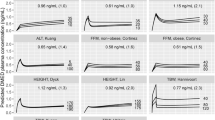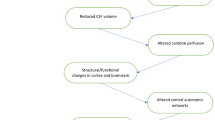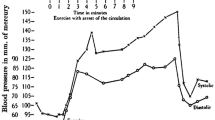Abstract
The effects of 0.4 or 0.8 mg paraoxon/kg i.v. on circulation and regional pre- and postganglionic sympathetic activity were studied in anaesthetized rabbits. At both doses, the discharges of the preganglionic efferents increased slowly, whereas the changes in activity of postganglionic efferents differed. Concomitantly with a transient initial rise in blood pressure a temporary increase of discharges to the skeletal muscles and to the intestine was observed which is attributed to spontaneous firing of the regional ganglionic cells. After injection of 0.4 mg/kg there occasionally occurred a second pressor reaction conditioned by enhancement of preganglionic activity and facilitated transmission in certain sympathetic ganglia.
After injection of the higher dose, postganglionic activity generally decreased except for the discharges of gastrointestinal efferents, which increased. Arterial blood pressure, cardiac output and total peripheral resistance fell markedly. A shock syndrome occurred which could be controlled by atropine injection if timely. From the results it was concluded that the higher dose of paraoxon blocked synaptic transmission in the paravertebral ganglia of the sympathetic trunk, and facilitated impulse transmission in the prevertebral abdominal ganglia.
Zusammenfassung
An narkotisierten Kaninchen wurde die Wirkung von 0,4 oder 0,8 mg Paraoxon/kg i.v. auf Kreislaufwerte und prä- und postganglionäre Sympathikusaktivität verschiedener Körpergebiete untersucht. Die Aktivität in präganglionären Sympathikusefferenzen nahm bei beiden Dosierungen langsam zu, während in den postganglionären Efferenzen teilweise gegensinnige Aktivitätsänderungen auftraten. Gleichzeitig mit einem flüchtigen initialen Blutdruckanstieg wurde eine vorübergehende Aktivitätszunahme in Sympathikusefferenzen zur Skelettmuskulatur und zum Intestinum beobachtet, die auf Spontanentladungen in den regionalen Ganglien zurückgeführt wird. Nach Injektion von 0,4 mg/kg kam es gelegentlich zu einer zweiten pressorischen Reaktion, die durch Zunahme der präganglionären Aktivität bei erleichterter Erregungsübertragung in bestimmten Sympathikusganglien bedingt war.
Nach Injektion der höheren Dosis wurde postganglionär überwiegend eine Aktivitätsabnahme beobachtet; nur die Entladungen gastrointestinaler Sympathikusefferenzen nahmen noch zu. Arterieller Blutdruck, Herzminutenvolumen und peripherer Gesamtwiderstand fielen stark ab. Es trat ein Schocksyndrom auf, das sich durch rechtzeitige Atropininjektion beherrschen ließ. Aus den Ergebnissen wird geschlossen, daß Paraoxon in höherer Dosis die Erregungsübertragung in den paravertebralen Grenzstrangganglien blockierte und die synaptische Übertragung in den prävertebralen Abdominalganglien erleichterte.
Similar content being viewed by others
References
Barnes, J. M.: The reactions of rabbits to poisoning by p-nitrophenyldiethylphosphate (E 600). Brit. J. Pharmacol. 8, 208–211 (1953)
Brown, R. V.: The effects of intracisternal sarin and pyridine-2-aldoxime methyl methanesulphonate in anaesthetized dogs. Brit. J. Pharmacol. 15, 170–174 (1960)
Crowcroft, P. J., Szurszewski, J. H.: A study of the inferior mesenteric and pelvic ganglia of guinea-pigs with intracellular electrodes. J. Physiol. (Lond.) 219, 421–441 (1971)
Daly, M. De Burgh, Wright, P. G.: The effects of anticholinesterases upon peripheral vascular resistance in the dog. J. Physiol. (Lond.) 133, 475–497 (1956)
Enders, A., Ruf, H.: Die Wirkung des Parathions auf das Zentralnervensystem. Arch. int. Pharmacodyn. 90, 175–184 (1952)
Gillis, R. A., Flacke, W., Garfield, J. M., Alper, M. H.: Actions of anticholinesterase agents upon ganglionic transmission in the dog. J. Pharmacol. exp. Ther. 163, 277–286 (1968)
Haefely, W.: Electrophysiology of the adrenergic neuron. In: Handbuch der experimentellen Pharmakologie (H. Blaschko, E. Muscholl, eds.), Vol. XXXIII, pp. 661–725. Berlin-Heidelberg-New York: Springer 1972
Hirt, A.: Vergleichend-anatomische Untersuchungen über die Innervation der Niere. Z. Anat. Entwickl.-Gesch. 73, 621–644 (1924)
Holaday, D. A., Kamijo, K., Koelle, G. B.: Facilitation of ganglionic transmission following inhibition of cholinesterase by DFP. J. Pharmacol. exp. Ther. 111, 241–254 (1954)
Holmstedt, B.: Synthesis and pharmacology of dimethylamido-ethoxy-phosphoryl cyanide (Tabun) together with a description of some allied anticholinesterase compounds containing the N-P bond. Acta physiol. scand. 25 (Suppl. 90), 1–120 (1951)
Holmstedt, B., Sjöqvist, F.: Distribution of acetocholinesterase in the ganglion cells of various sympathetic ganglia. Acta physiol. scand. 47, 284–296 (1959)
Jacobowitz, D.: Catecholamine fluorescence studies of adrenergic neurons and chromaffin cells in sympathetic ganglia. Fed. Proc. 29, 1929–1944 (1970)
Kamijo, K., Koelle, G. B.: The relationship between cholinesterase inhibition and ganglionic transmission. J. Pharmacol. exp. Ther. 105, 349–357 (1952)
Kebabian, J. W., Greengard, P.: Dopamine-sensitive adenyl cyclase: possible role in synaptic transmission. Science 174, 1346–1349 (1971)
Koelle, W. A., Koelle, G. B.: The localization of external or functional acetylcholinesterase at the synapses of autonomic ganglia. J. Pharmacol. exp. Ther. 126, 1–8 (1959)
Kuga, T., Erdmann, W. D.: Über die Wirkung von Paraoxon auf die elektrische Aktivität des efferenten Halssympathicus und den Blutdruck der Ratte. Naunyn-Schmiedebergs Arch. Pharmakol. exp. Path. 258, 457–470 (1967)
Kullmann, R., Junk, H. G.: Differential sympathetic response during coronary occlusion. Res. exp. Med. 160, 317–320 (1973)
Kullmann, R., Uerdingen, U.: Sympathetic activity in various pre-and postganglionic efferents during paraoxon poisoning. Naunyn-Schmiedeberg's Arch. Pharmacol. 297 (Suppl. II), R 33 (1977)
Libet, B.: Long latent periods and further analysis of slow synaptic responses in sympathetic ganglia. J. Neurophysiol. 30, 494–514 (1967)
Libet, B., Tosaka, T.: Dopamine as a synaptic transmitter and modulator in sympathetic ganglia: a different mode of synaptic action. Proc. nat. Acad. Sci. (Wash.) 67, 667–673 (1970)
Norberg, K.-A., Sjöqvist, F.: New possibilities for adrenergic modulation of ganglionic transmission. Pharmacol. Rev. 18, 743–751 (1966)
Preston, E., Heath, C.: Depression of vasomotor system in rabbits poisoned with an organophosphate anticholinesterase. Arch. int. Pharmacodyn. 200, 245–254 (1972)
Rand, M. J., McCulloch, M. W., Story, D. F.: Pre-junctional modulation of noradrenergic transmission by noradrenaline, dopamine and acetylcholine. In: Central action of drugs in blood pressure regulation (D. S. Davies, J. L. Reid, eds.), pp. 94–132. Tunbridge Wells: Pitman Medical 1975
Rosenberg, P.: In vivo reactivation by PAM of brain cholinesterase inhibited by paraoxon. Biochem. Pharmacol. 3, 212–219 (1960)
Schmidt, G., Grützmacher, J.: Spätreaktionen an Atmung und Kreislauf nach erfolgreicher Behandlung der Paraoxonvergiftung mit Esterasereaktivatoren und Atropin an Katzen. Arch. Toxikol. 24, 102–122 (1969)
Skok, V. I.: Physiology of autonomic ganglia, pp. 33–45. Tokyo: Igaku Shoin 1973
Takeshige, C., Volle, R. L.: Bimodal response of sympathetic ganglia to acetylcholine following eserine or repetitive preganglionic stimulation. J. Pharmacol. exp. Ther. 138, 66–73 (1962)
Takeshige, C., Volle, R. L.: Asynchronous postganglionic firing from the cat superior cervical sympathetic ganglion treated with neostigmine. Brit. J. Pharmacol. 20, 214–220 (1963)
Trendelenburg, U.: Some aspects of the pharmacology of autonomic ganglion cells. Ergebn. Physiol. 59, 1–85 (1967)
Volle, R. L.: Ganglionic transmission. Ann. Rev. Pharmacol. 9, 135–146 (1969)
Volle, R. L., Koelle, G. B.: The physiological role of acetylcholinesterase (AChE) in sympathetic ganglia. J. Pharmacol. exp. Ther. 133, 223–240 (1961)
Warren, D. J., Ledingham, J. G. G.: Chronic left atrial catheterisation in the rabbit. Pflügers Arch. 335, 167–172 (1972)
Wilcoxon, F.: Probability tables for individual comparisons by ranking method. Biometrics 3, 119–122 (1947)
Wirth, W.: Zur Pharmakologie der Phosphorsäureester. Diäthyl-p-nitrophenylphosphat (“Mintacol”). Naunyn-Schmiedebergs Arch. exp. Path. Pharmak. 207, 547–568 (1949)
Author information
Authors and Affiliations
Additional information
The authors dedicate this work in gratitude to Professor Dr. R. Domenjoz, on the occasion of his seventieth birthday
Rights and permissions
About this article
Cite this article
Kullmann, R., Uerdingen, U. Regional pre- and postganglionic sympathetic activity during experimental paraoxon poisoning. Arch. Toxicol. 41, 49–60 (1978). https://doi.org/10.1007/BF00351769
Received:
Issue Date:
DOI: https://doi.org/10.1007/BF00351769




